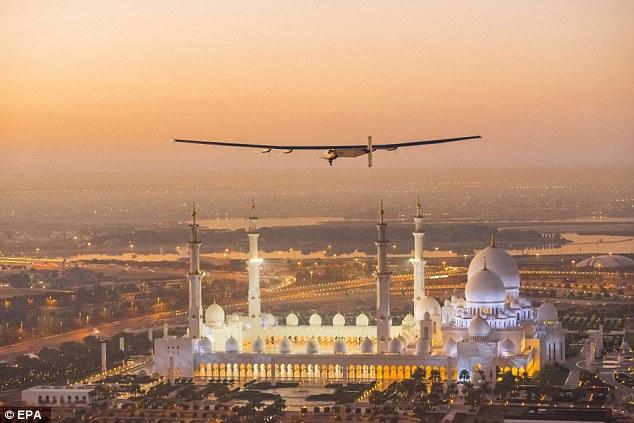How can a huge, slow, single-seat plane change the world?
One day before the United States pauses to celebrate the 239th anniversary of its Declaration of Independence, the Solar Impulse 2 solar airplane completed its record-breaking 4,000 mile flight from Japan to Hawaii, taking another small step in the world’s quest to declare independence from fossil fuels.
The Adventure Begins
 For those who haven’t been following the Solar Impulse adventure, here’s a little background: Solar Impulse is privately financed project with the goal of flying a solar-powered plane around the world. Based in Switzerland, the project is led by two adventurous aeronauts– Swiss businessman André Borschberg and adventurer Bertrand Piccard (Piccard gained fame for co-piloting Breitling Orbiter 3, the first balloon to circle the world non-stop.) Solar Impulse is funded by a consortium of international businesses including Omega SA, Solvay, ABB, Bayer MaterialScience, Swisscom, Swiss Re , Toyota and FMB Energie. The Solar cells are provided by European solar manufacturer SunPower.
For those who haven’t been following the Solar Impulse adventure, here’s a little background: Solar Impulse is privately financed project with the goal of flying a solar-powered plane around the world. Based in Switzerland, the project is led by two adventurous aeronauts– Swiss businessman André Borschberg and adventurer Bertrand Piccard (Piccard gained fame for co-piloting Breitling Orbiter 3, the first balloon to circle the world non-stop.) Solar Impulse is funded by a consortium of international businesses including Omega SA, Solvay, ABB, Bayer MaterialScience, Swisscom, Swiss Re , Toyota and FMB Energie. The Solar cells are provided by European solar manufacturer SunPower.

The single seater plane is powered only by solar, with a wingspan of 236 ft. (wider than a Boeing 747), yet weighs less than an SUV. The wings and fuselage are covered with 17,248 photovoltaic cells rated at 66 kW. It has four, 17.4 horsepower electric motors and four 41 kWh lithium-ion batteries. It has a maximum speed of 78 miles per hour.

Solar Impulse 1, the prototype and predecessor of the current model, achieved many “firsts” for a solar plan, including the first intercontinental flight for a solar airplane, flying from Spain to Morocco. However, Solar Impulse 2 has achieved truly epic flights since taking off on the first leg of the journey from Abu Dahbi in March, 2015. The journey has taken Borschberg and Piccard across Asia, over Oman, India, Myanmar and China, across the Pacific to Japan, and now to Hawaii. The latest 118 hour leg, completed by Andre Borschberg, is a record for manned, solar-powered flight, as well as an absolute record for a solo, un-refuelled flight. Borschberg’s time beats that of the American Steve Fossett who spent 76 hours in a single-seater jet in 2006. If all goes well, the Solar Impulse’s two pilots will break more records before finishing their circumnavigation of the globe. The final leg of the flight, from New York to Morocco, will take an estimated 120 hours.
Why the Solar Impulse Matters
Great feats of endurance have always captured the human imagination. Some are achievements of great physical training and mental discipline, like British Cyclist Alex Dowsett’s recent shattering of track cycling’s world one hour record by 446 meters. Other great feats include a technical element as well. Take, for example, Australian skydiver Felix Baumgarter’s jump from a balloon 24 miles above the earth’s surface. In a special pressurized spacesuit, Baumgartner became the first person to break the sound barrier without vehicular power. Solar Impulse is one step beyond even these amazing recent achievements. Requiring the physical endurance of a marathon runner and the nerves of a test pilot on the part of Piccard and Borschberg, there is no denying the human endurance element. But there is even more to what Solar Impulse represents. 
Obviously, we aren’t going to be traveling in solar airliners any time soon, but Solar Impulse exhibits the rock solid reliability of current solar technology, as well as presenting another successful example of combining solar with lightweight Lithium-Ion battery tech. Solar Impulse is taking Elon Musk’s Tesla electric car concept out to its “bleeding edge.” Solar Impulse ignites the imagination, opening up a whole world of possibilities for solar powered transport. It can also spark an interest in science and technology in kids who may not have seen a really exciting application before. 
Gliding quietly over deserts, jungles and oceans, Solar Impulse leaves no contrail, no “environmental footprint.” It is a symbol of what is best about the human “impulse” for adventure. The epic aeronautic voyage transcends borders and cultures. Piccard and Borschberg are sharing peace and goodwill in countries that may not share political or economic philosophies, but all share a love of great human achievement. Without massive government backing or huge military research budgets, Solar Impulse is a soaring example of what technology should be.
——–
About the Author: Rich Dana serves as Director of Microenterprise Development for the Sustainable Living Department at Maharishi University of Management. He works with students to develop ideas and implement new projects. He is a serial entrepreneur, a freelance writer and partner in Plan B Consulting. He has served as an energy specialist at the National Center for Appropriate Technology and President of the Iowa Renewable Energy Association. At 53, he still likes to climb on roofs and install solar equipment.





